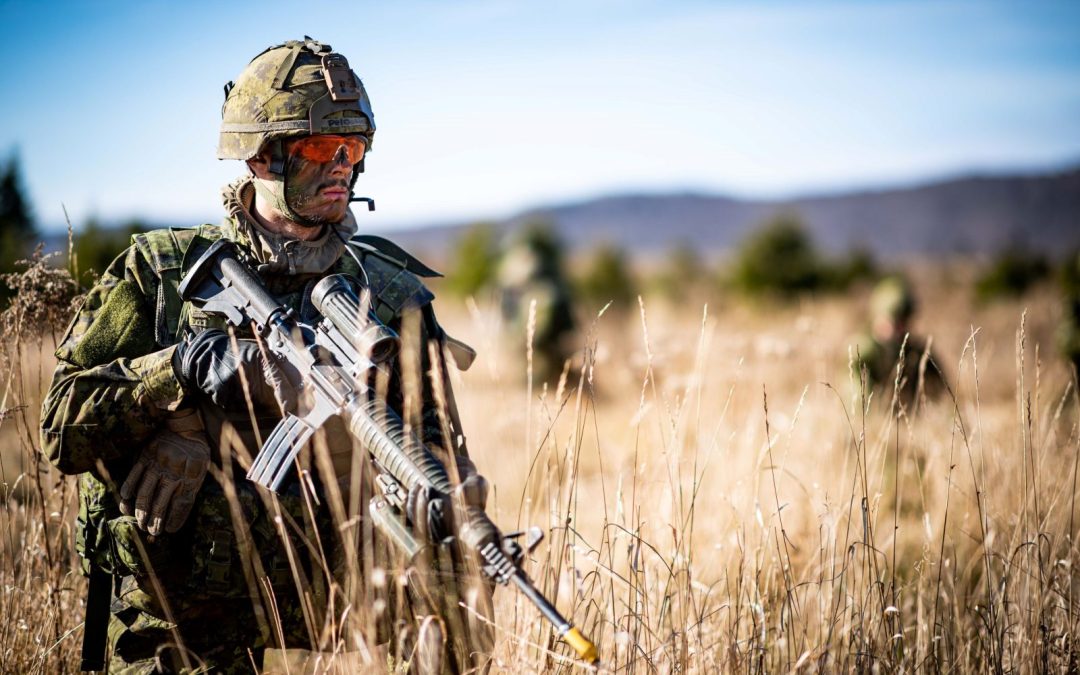by Ken Pole
When the federal government rolled out its June 2017 defence policy paper, it was packaged as “a long-term vision” for how Canada’s military could respond to a rapidly changing world. It was an ambitious vision built around a promise to spend billions more on defence over the ensuing two decades.
Among other things, it stated that “the Department of National Defence remains committed to the significant and strategic long-term investments that will ensure the Canadian Armed Forces (CAF) continues to function as an agile, and combat-ready force, capable of making tangible contributions and delivering on its commitments at home and around the world.”
A critical element of that 2017 vision, which is expected to be updated in a new policy paper promised in the April 2022 budget — six weeks after Russia spiked global tensions by invading Ukraine — is the need to provide the Army with new small arms and other light weapons for its dismounted troops.
Since 2017, the Army has moved ahead with the new C20 and C21 sniper rifles and is now introducing the Sig Sauer P320 as its new pistol of choice, designated the C22. But replacing its Colt Canada C7 family of standard-length assault rifles and shorter and lighter C8 carbines remains a work in progress.
Both have proven effective in various theatres of operation, but they have been in service for more than three decades. Major Carl Gendron, who directs the Army’s small arms and light weapons program, says their effectiveness has been eroded over the years by simple wear and tear.
He told Canadian Army Today that Canada has reached a point within NATO, where it ranks near the bottom in terms of assault rifle modernity. “We’re not competitive with what’s been available for the last 20 years and they do start to degrade with time.”
Most NATO countries have “moved on” and Canada is “overdue to bring its capabilities up to speed,” he said. Gendron warned that “our operators who use their assault rifles for dismounted offensive operations or personal protection now risk being overmatched by adversaries using readily available technologies.”
The Army’s solution is the Canadian Modular Assault Rifle (CMAR), which could be adopted to various tactical scenarios by changing components procured through Colt’s subcontractors or other certified manufacturers. The expectation is a weapon it says will “enhance the awareness, lethality and protection of deployed CAF members.”
The CMAR project was presented to an Independent Review Panel for Defence Acquisitions in July 2020. While it acknowledged the Army’s specific needs for its dismounted operators, the panel also suggested that the entire CAF assault rifle fleet requirements be addressed. This led the Army to rethink how it could achieve this within a reasonable funding envelope and without jeopardizing the operational effectiveness of the Army.

To support CMAR project viability and avoid delays, the Army and Assistant Deputy Minister (Materiel) (ADM (Mat)) simultaneously conducted market surveys, testing and prototyping to validate the way ahead. In the same vein, the Army is also championing a C8A4 upgrade initiative and using it as a testbed to confirm CMAR requirements.
The current thinking favours a two-tier fleet of modular weapons that retains the familiar C7/C8 configuration, but with a floating barrel and full rails that can accommodate options for advanced day optics, night vision systems, thermal sights, grenade launchers and individualized ergonomics.
This two-tiered approach would result in a Tier 1 Full Spectrum (CMAR-FS) rifle optimized for offensive operations in urban and open terrain, and a Tier 2 General Service (CMAR-GS) rifle designed for support and personal protection. This is similar to how the U.S. Marine Corps uses its Heckler & Koch M27 rifles and Colt M4 carbines.
Both variants would also be fitted with a sound suppressor that doubles as a muzzle brake. “It’s good for reducing sound signature, facilitating voice command and control, saving shooters’ hearing, and making quick follow-on shots much more accurate,” Gendron said.
It is understood that even the Tier 2 General Service rifle would have superior target acquisition, accuracy and ergonomics, and would surpass most other assault rifles on the market.
Gendron would not go into details about the Tier 1 Full Spectrum, but he said “the General Service and Full Spectrum rifles are very similar. The Full Spectrum will have a different barrel for better accuracy and will also have more sophisticated optics. It’s all the peripherals that change.” He said a basic FS variant has already been tested with new ammunition and delivered better results than expected.
There is ongoing debate about the ammunition. For decades, the Canadian Army has used the 5.56 mm NATO calibre, one of five NATO time-tested standards, which range up to 12.7mm. The U.S. Army has been pushing for more combat punch with their Next Generation Squad Weapons (NGSW) using a new 6.8 mm cartridge. Without going into details, Gendron has acknowledged that he and his team of elite shooters, weapons technicians and engineers have shot both the NGSW’s XM7 and XM250, and are tracking the NGSW program. While not opposed to new technologies, Gendron’s response was that there are serious considerations to using magnum-level cartridges and that, until a new assault rifle cartridge is agreed upon by NATO, the 5.56 is “sufficiently potent” for how it’s used by Canadian troops.
That said, he also revealed that prototyping work, in conjunction with General Dynamics Ordnance and Tactical Systems–Canada, is looking at refining the current C77 5.56 mm into a toxic-free option for the CMAR, and that “we have extremely encouraging results in terms of terminal effect and extending current effective ranges from live-fire prototype tests.”
Currently, the Army and ADM (Mat) are working towards a validation of the C8A4 as a tangible lead-in to the CMAR project while also grinding through the procurement process.
“The current aim is to finalize the configuration of the C8A4 so that it can become a valid option for the CMAR project,” Gendron explained. Having standardized that way should make future procurements relatively straightforward. “If all goes well, the final C8A4 setup should meet the requirements of the CMAR GS and could start replacing the bulk of the C7/C8 fleet.”
However, technical challenges with suppressors and optics, supply chain issues, coupled with “chronic shortages of specialized staff,” have resulted in delays to the C8A4 and, by extension, the CMAR.
Even so, Gendron said, Colt Canada has produced 500 basic C8A4s which will be distributed to select Army and CAF units “within a month or two,” along with different scopes, for “final user input” before the configurations of some key elements are locked down.
“In the first few months of 2024, we’re going to have an idea of what we want to change in the configuration,” he said. That would include feedback from the units getting those 500 basic weapons. Gendron was reluctant to say which units would be involved because final allocation would depend on which ones are available when the depot is ready to ship. Initial depot-level distribution is expected in November, and he expects feedback “roughly” by January, at which time a human factors specialist would distill preferences or recommendations into a practicable package.
The Directorate of Land Requirements staff hopes to obtain initial funding in the 2024-2025 fiscal year and start production within two or three years after that. But CMAR timelines and scope remain contingent on the prioritization of staff efforts and funding.
As for that NATO ranking, Gendron said that if the CMAR project works as he hopes, he’s optimistic Canada will comfortably return to the top tier when it comes to the Army’s small arms effectiveness.





“This two-tiered approach would result in a Tier 1 Full Spectrum (CMAR-FS) rifle optimized for offensive operations in urban and open terrain, and a Tier 2 General Service (CMAR-GS) rifle designed for support and personal protection. This is similar to how the U.S. Marine Corps uses its Heckler & Koch M27 rifles and Colt M4 carbines.”
I don’t think that’s quite correct. The M27 is not intended to replace M4s in USMC infantry battalions. It is intended to replace the M249 squad automatic weapon (SAW), known in Canada as the C9 light machine gun. There is no ‘Tier 1’ or ‘Tier 2’ hierarchy of weapons here. Front-line Marines who carry the M4 will continue do so while SAW gunners are re-equipped with the M27 based on its (expected) ability to deliver accurate fire rather than a high volume of fire.
Isn’t the M27 a variant of the HK416 (which is very physically similar to the M4)? If their goal was to replace a LMG, wouldn’t it still be belt fed to be able to deliver as much volume of fire down range? (this is my opinion from the limited knowledge I have on these firearms so I might be mistaken, but I find the subject very interesting)
Shawn – the introduction of the M27 IAR was not without controversy in USMC circles. Some felt that volume of fire was more important. They also felt that having to change magazines more frequently would be a disadvantage. In the end, the advocates of short-burst, accurate fire from an assault rifle derivative carried the day. They also expressed some confidence that, in closer engagements, the enemy would no longer be able to distinguish between the M4 user and the support gunner, as the M4 and the M27 share similar characteristics.
I should have pointed out that the ‘solution’ goes beyond the rifle itself. Like the notional CMAR, the USMC infantry automatic rifle is combined with an advanced optics package to enable the gunner to put those fewer rounds on target. Thus the gun and the sight are inseparable. Whatever emerges from the CMAR project, one should expect that a significant portion of the costs will be devoted to optics – at least for the weapons allocated to the infantry.
It looks like one of the hundred or so fancy AR-15’s variants that you see Guntubers carting around. It strikes me as sad that the CAF are struggling to catch up to civilian hardware.
Clay, I don’t know that it is necessarily sad that the CAF explores options inspired by those available to civilian shooters. A healthy rifleman’s culture provides ideas and concepts from a broad spectrum that can serve to avoid the tunnel vision that tends to plague procurement programs.
The USMC decided that all regular riflemen in the infantry (0311 is the MOS) would be issued the M27 in place of the M4. The M249 would be retained for use on a mission specific basis and the M240 would still be the general purpose machine gun. For all other Marines, the M4 remains the standard weapon. The goal is have enough M27s to supplant the single (or two) M249s. Also, the USMC is increasing the size of it’s standard squad from ~9 to 13-15 depending on the mission.
USMC squads have always been 13. Three fire teams of four Marines and a squad leader
This is excellent news.
Not sure why a weak intermediate cartridge would require a M-7 style ‘magnum’ 6.8mm ‘smuzzle’. In a full length barrel, maybe emphasis should just on sound reducation, and keeping it as short as possible.